I couldn’t tell you what Renaissance masterpieces I marveled at or which churches I visited during the two times I’ve been to the red-roofed dream of a city that is Florence. All I know for certain is that on both trips I lingered rapturously over fresh, wide pappardelle ribbons with wild boar sauce, rich with shredded meat in a slow-cooked wine and tomato base.
Wild boars (cinghiale, pronounced ching-GYAH-lay), ancestors of domesticated pigs, aren’t cute pink Babes. Dark, shaggy boars run wild in the mountains and forests of Italy, devouring grubs and acorns, chestnuts and truffles. They wreak havoc on gardens and crops, much like deer in the United States, and like deer-hunting season here, each winter Italy sanctions wild boar hunting to thin out the feral population that is no longer kept in check by bears and wolves.
The meat of wild boar, leaner than domesticated pork as well as darker and richer tasting, is made into salami, sausage, and prosciutto di cinghiale. In Tuscany it’s common on menus to find ragù di cinghiale, made with fresh wild boar meat and Tuscan wine, more often than not paired with fresh, eggy pappardelle noodles.
I haven’t been to Tuscany for 15 years, and I haven’t made this sauce for probably 10. But eating it now, I remember the frescoed storybook city of Florence, nestled in a valley with Tuscany’s scenic hills all around, the Arno winding through town as a picturesque excuse for scenic bridges and mirrored architecture in its waters. I see shimmery grey-green olive trees with gnarled branches, and forest-green cypress standing upright, tops gently waving.
And I remember how pleased I was when I first made this sauce in our first house, sometime after our first baby, when I was home-bound and wistful for the concept of a holiday away. Even with plain old pork, it was very much like what I remembered from Tuscany – the wine, the rosemary, the tender meat.
I love how food can transport us to another place, another time.
The sauce doesn’t need any skill, just some undisturbed time on simmer. Some chianti, chopped aromatics (celery, carrot, onion, garlic, rosemary), canned tomatoes and a dab of tomato paste (not pictured). Big chunks of pork shoulder, well seasoned with salt and pepper.
Briefly sear the meat.
Add aromatics with a few bay leaves, and cook a few minutes to soften.
Add wine and cook, turning meat, until it is mostly boiled off.
Add tomatoes, with additional water to cover the meat by 1/2 inch.
Cover and simmer on very low heat for 2 to 3 hours.
Until meat falls apart easily with a fork.
Add tomato paste and a pinch of sugar.
Finish the sauce with a bit of butter if you like. Or not.
Pappardelle, penne, polenta – it’s all good. Just don’t forget the parmiggiano.
And conveniently there’s leftover wine from cooking to join you for your meal, so you can go straight from eating Tuscany to dreaming about it.
Tuscan Wild Boar Sauce (no boar required)
This slow-cooked, winey sauce with shredded meat, a Tuscan classic that incorporates the wine, rosemary and wild pig of the region, has the power to transport me to dreamy Florence. Adapted from Jamie Oliver via Leite’s Culinaria, with plain old pork standing in for its wild counterpart.
Ingredients
- 1 pound pork shoulder
- Kosher salt and freshly ground pepper
- 2 tablespoons olive oil
- 1 small onion, chopped (about 1 cup)
- 1 stalk celery, chopped (about 1/2 cup)
- 1 medium carrot, chopped (about 1/2 cup)
- 3 garlic cloves, minced
- 1 tablespoon fresh rosemary leaves, chopped
- 3 Mediterranean bay leaves
- 1 cup chianti (some kind of sangiovese or blend)
- 1 28-ounce can plum tomatoes
- 2 tablespoons tomato paste
- 1/4 teaspoon sugar
- 2 tablespoons butter (optional)
- Grated Parmesan cheese
- Fresh parsley, chopped
Preparation
- Cut meat into large chunks and season with salt and pepper. In a Dutch oven or heavy pot with lid, heat olive oil over medium-high heat and sear meat until golden brown on all sides.
- Add chopped onions, carrot and celery, along with garlic, rosemary and bay leaves. Turn the heat down and continue to cook for 5 minutes, until the vegetables have softened.
- Add red wine and continue to simmer, turning the meat to coat, until the liquid has almost cooked away.
- Add tomatoes and just enough water to cover the meat by 1/2 inch. When liquid comes to a boil, cover and simmer over very low heat for 2 to 3 hours, until a fork can easily shred the meat in tender strands.
- Remove the meat from the pan and use two forks to shred it, discarding any large pieces of fat.
- Using a wooden spoon, mash any chunks of tomato in the sauce, and add tomato paste and sugar. Season well with salt and pepper to taste (depending on your tomatoes, you’ll probably need a good amount of salt here, maybe a teaspoon of kosher salt or 1/2 teaspoon table salt). Put the meat back in the pan and heat over low. Finish the sauce with butter if desired.
- Toss with hot pasta, adding a little pasta cooking liquid to loosen the sauce, and top with grated Parmesan and parsley. Or serve over polenta.
Notes
- Slow cooker variation: No need to brown the meat or vegetables in a skillet first, just add all ingredients in the slow cooker (except finishing ingredients of butter, Parmesan and parsley) and cook on low for 8 or so hours, until meat is fork-shreddable (no additional water needed). If the sauce seems too runny, simply remove the meat, crank the slow cooker to high, and simmer until the liquid is reduced to the desired consistency. Shred meat and season sauce as described above, finishing with butter if you like.
- Pork shoulder (or butt, which, oddly, is also from the shoulder) will give best flavor here, but you could make do with big chunks of pork loin. It’s leaner and drier, but the moisture of the sauce should compensate.
- Time saver: chop your onion, celery, carrot and garlic in the food processor. Smaller is better for this sauce, so a finely minced pile of aromatics in this case is even preferable to hand-chopped.
- Pasta cooking tips: Cook pasta in plenty of boiling water, salty like the sea, until it has just a bit of chew left in the center. Save a cup of cooking liquid before you drain the pasta. Toss hot pasta immediately with sauce, adding a bit of cooking liquid to loosen the sauce. Serve hot, topped with plenty of Parmesan and parsley (or a bit more fresh rosemary).
Here’s the link to a printable version.

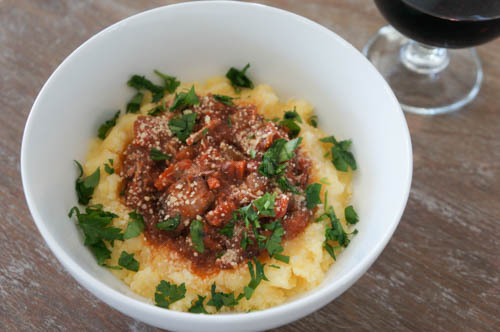
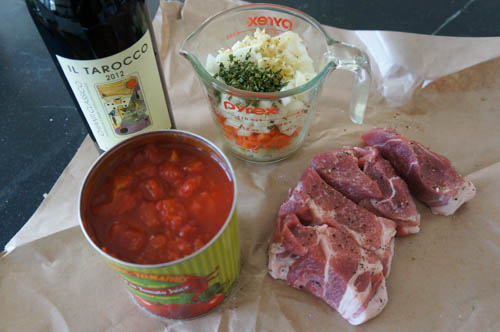

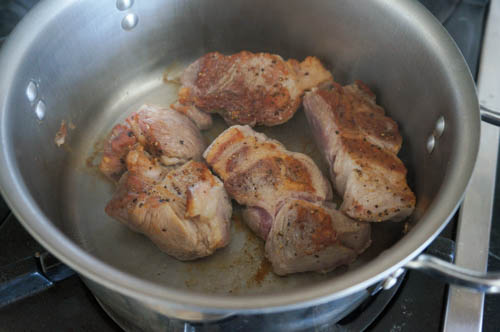
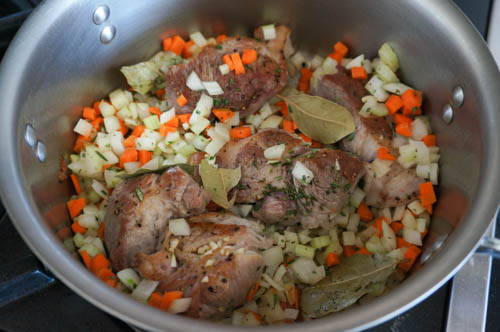
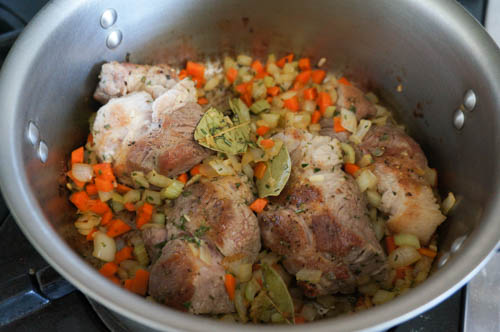
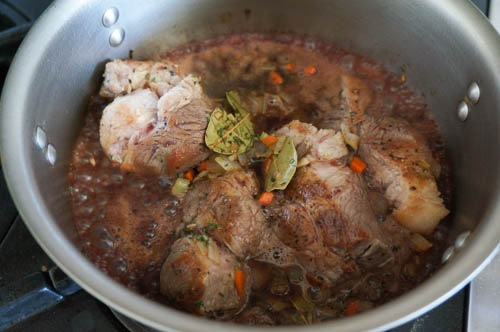
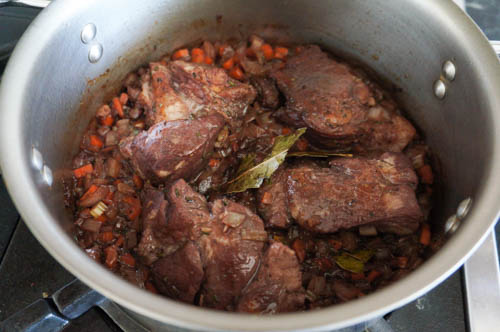
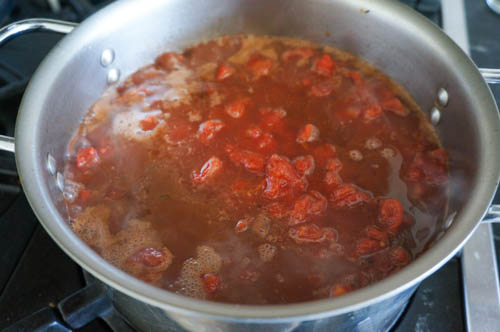

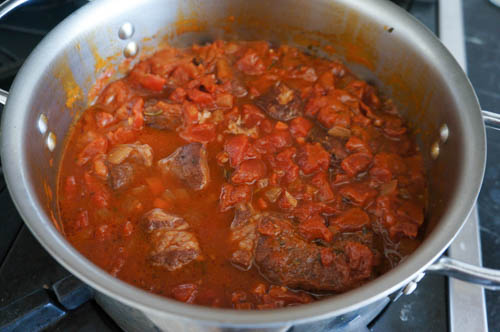
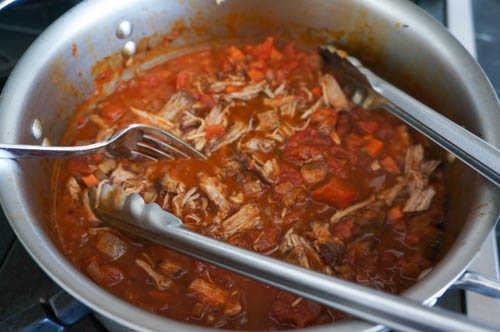
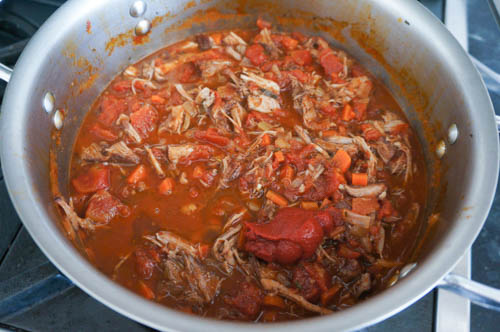
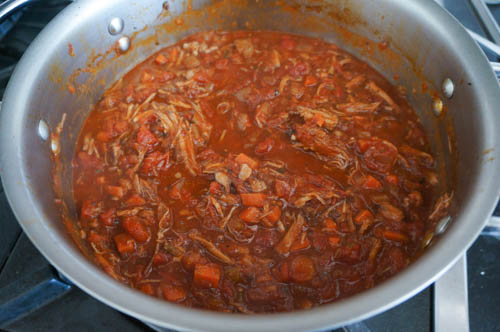
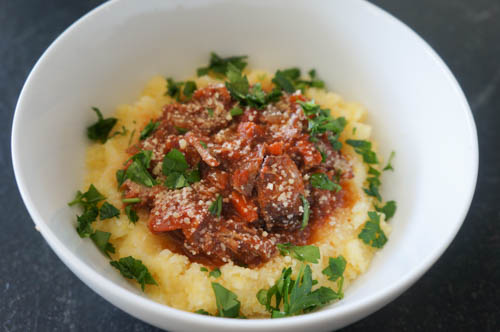




Feral pigs are a major problem in the US and Canada. They do around $1.5 billion worth of damage yearly to agriculture and the environment in the 47 states they established in.
We need more people to hunt and eat them.
http://wildpiginfo.msstate.edu/index.html
http://thinkprogress.org/climate/2013/11/27/3002821/wild-pigs-hogs-invasive-desctruction/
http://wildboarcanada.ca/
hi wolfsbane – hmm, i wonder if our north american feral pigs aren’t as tasty as the italian ones. pigs eat anything, so maybe they’re gorging on junk instead of nice acorns. i’d gladly eat it, if someone would hunt me a good one. thanks for sharing the links – interesting!
http://www.seriouseats.com/2014/04/why-you-should-be-eating-more-wild-pigs-right-now.html
I’m curious as to why you think the wild pigs in North America are eating junk. With the exception of truffles, they probably eat about the same things that their European cousins eat. Plus, I suppose the ones in Italy, (since they are also wild, omnivorous, and their menus unmonitored), occasionally eat things that most of us would find repulsive. Pigs are, after all…pigs.
hi cheepmaters – thanks for sharing the link! i agree, pigs aren’t picky eaters, so i guess it just depends what’s available where the pigs are running wild. wild boar from a largely unoccupied forested area has got to be very different from wild boar in populated areas. commenters to the serious eats article debated this also, some people saying wild boar is great tasting, and others saying wild boar can be really icky if they’ve been feeding on garbage and roadkill. really appreciate your contribution to the discussion! i’m a suburban girl, what do i know?
I have a friend from Austin TX who says that they can’t leave their trash cans outside because the pigs come and open them up (knock them over and break, I assume) and eat all of the trash. She said that people CAN hunt them, but generally don’t.
hi sandra – wild boar look intimidating, i wouldn’t want them barreling over my trash! where i’ve lived in ohio and california, it’s only raccoons.
They’re more than intimating. They have 5″ razor sharp tusk that can do a lot of damage. If you have a dog, keep them inside. Pigs hate dogs with a fiery passion and will kill them if they get the chance.
If you live in a state that has them, it’s likely just a matter of time until they get to where you live. Germany has a major problem with urban wild boar in Berlin. They have a sounder of around 3000 that’s wreaking havoc.
Imagine a bunch of them camped out on your front lawn when you’ve come home from the grocers. They know you have food and demand you turn it over to them
http://www.npr.org/2012/11/06/164435055/in-berlin-a-boar-of-a-story
http://www.wsj.com/articles/SB122937877627908421
Well the $1.5B in yearly agriculture damages says they’re eating a lot of agricultural products. I’ve pictures of freshly planted fields they’re dug up and totally destroyed in a single night.
They’re omnivorous so they eat whatever they can find. Hunters like killing them because they eat the eggs and nestlings of ground nesting game birds like wild turkeys and also deer fawns. Basically whatever they can catch.
hi wolfsbane – good point, i guess it all depends on where they live and what there is to forage/pilfer. in huge swaths of the midwest, it seems like all that we grow anymore are commodity corn and soy (thanks, farm bill). in california there’s more variety, and more real food.
Looks tasty!!
thanks, jerrelle!
I was looking for a recipe to feed a hungry crew of 12 after a hockey game. This looks hearty and perfect! Love anything that can be made in a crockpot.
hi mich – can you believe i don’t own one? i borrow my mom’s! now that i have room to store one, i might have to get my own. they are so useful.
I don’t know if you’ve checked Eat Wild, but they have high quality boar meat available. I tried to look up board in your state, but “midwestern” is kind of vague, so here’s the link for you: http://www.eatwild.com/products/index.html
hi sandra – very cool link, thanks for sharing! my location is confusing here, because while i’ve had the blog we’ve lived in both ohio and california. and even now that we’re back in my native california, we still spend a lot of time in ohio with my husband’s family when the kids are not in school.